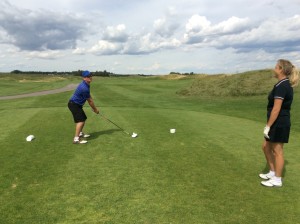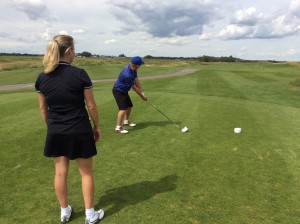Our twosome turned into an odd experience, a foursome where our playing partners were a Pro giving on-course lesson to his student…
Making Nice on the Golf Course
The Dixie Chicks may not have been ready to make nice in their 2007 hit country song, but the golf course is not just a place to be nice, but respectful – and kind.
My last entry about golf course etiquette was all about time management, and how golfers need to know how to manage so we can show up at the golf course with enough time to do the things we need to. That includes paying, a warm up and an equipment check – to make sure we have everything we need for our upcoming round.
Today I’m going to tell you what makes for good etiquette once you’re playing and this post deals with everything except the greens – as the greens warrant at least a post of its own!
So much of etiquette on the golf course is down to good manners as well as time management, once again! The course marshal will be the first one to let you know if your time management is lagging but you can see it straight away if you cannot keep up to the group in front of you. You won’t lag behind if you can keep them in your sight – so keep them in your sights!
Slow play is especially critical on busy golf days, when the foursomes are booked from sunrise to deep into the afternoon and everybody wants to be out, enjoying a round of golf. If you’re group is slow, the folks behind you are slowed down too, and that means that starting times, which may be spaced just 8 minutes apart, will get quickly backed up. That domino effect is bad for not just the reputation of the golf course, but the enjoyment of the players on, or about to get on, the course.
Don’t be afraid to wave the group behind you through. If you’re slow and they’re not, give them the break. And although single players don’t have priority on the course, I’ll wave them through – if there’s any room between my group and the group ahead.
Although the golf course isn’t the place to read up on the rules of the game, if you end up being in a situation where you need to consult the rule book, you should know where to look – and that’s much easier to do if you’ve read through it beforehand. The Rules of Golf are certainly complicated (and there are books published every couple of years called Decisions on the Rules of Golf that spell out particular circumstances and the rulings that went along with them). For the most part, however, you should know what to do with white, red, yellow and blue stakes and lines and what your relief should be if your ball ends up on the other side of those markings.
Be ready to make your shot when it’s your turn. That means that once the next-closest player to you has hit his or her ball, you need to quickly advance to your ball, assess which club you will need for the distance, and make your shot when it’s safe to do so. If the flight in front of you is on the green and you have the ability to reach them with your next shot, wait until the green is cleared before you hit your approach.
Don’t forget to yell “FORE” if your ball is in danger of hitting anyone at any time. You might not be able to see if people are on the adjacent fairway, but assume they are and they might get hit by your errant ball.
Don’t pay attention to only your ball: watch where your playing partners’ balls go too. Another set of eyes may help a player decide if they should play a provisional ball, for example, if it’s gone out of bounds, or will speed up the search for a ball that lands off the fairway. And don’t get ahead of where they are as you go up the fairway: not only do you risk being hit, having people in front of you as you make a shot can be disturbing. Don’t be rude: stay behind.
It doesn’t matter where you are on the course, never forget that you need to take good care of it. Unless you’re expressly told otherwise by the starter, you need to repair your divots the best you can – including on the tee box as well as the fairways. If you’re not sure how to repair divots, read this post by Patrick Hodgson on the correct way to repair divots. Usually there are wooden or plastic boxes with a mixture of grass seed and dirt in them located next to the tee box – so if you create a divot there, you can use the seed box to repair it. And if you’re driving a golf car, there are usually seed boxes on the car to help you repair your divots on the fairway.
If you’re driving a golf car, carrying your bag or using a hand cart, never park them on a tee box. Park your cart, bag or car on the cart path or grass next to the tee box. When partnering on a car, think about which of you should walk up to the green, taking their clubs with them for chipping and putting, while the other person takes the car green side. Adhere to the 90 degree rule if it is mandatory, and stay off the fairways where indicated. If you can drive on the fairways, try to stay out of damp areas, if you can.
It is common courtesy not to TALK when someone else is hitting their ball. (In my opinion, whispering is even worse! It’s the same no matter where you are on the course: on the tee, on the fairway or on the green. As for noise, don’t forget to turn off your cell phone, or put it on mute. After all, you’re outdoors and you should enjoy everything there is to enjoy about that outdoor experience: the birds singing, crickets and frogs chirping, the sound of the wind through the trees.
The picture I’ve used at the top of this post is one I took of my friend, Ruth, when we were at the beautiful Cobble Beach Golf Course on Georgian Bay in Ontario in July – it’s moved up 11 spots to being the 17th best public courses in Canada by ScoreGolf.com – and we loved the course. I decided to use this picture because, since I’m talking about manners and golf course etiquette, you can see how much space she has on the tee box. No one is crowding her, she has all the space all to herself to make a great shot. And she did!
Make nice on the golf course. Your fellow players, and the golf course will appreciate it!
In my next entry about golf course etiquette, I’ll talk about manners on the greens.
Golf Course Etiquette – Getting Ready to Play
Etiquette in golf is not just good manners and being courteous! It’s a code of behaviour that every player should learn.
First and foremost, golfers need to be time managers, both before they get to the course, and while they’re on it. Manage yourself so you arrive early – and be ready to play ahead of time. I know it’s not always possible to do it — especially if you’re battling traffic or a meeting that’s gone on too long — but, in general, you should be at the course at least 45 minutes before your tee time. That will give you the time you need to check in and pay, warm up with a bucket of balls on the driving range, sink some putts on the putting green, and arrive at your #1 tee box 10 minutes ahead of time.
Those 45 minutes can also be used to cut down on the amount of fidgeting you might otherwise need to do if your golf bag isn’t properly organized – so give it the once-over before you hit your first ball on the driving range. That means that your clubs are in order, that you have everything you need. That will include: balls, tees, a pitch mark repair tool, a marker, a counter, and a good glove and may also include a range finder. It’s important to know where everything is within your bag.
When you check in at the pro shop, tell them your name and what your tee time is. Pay for your round of golf and for your range balls, if there is a fee.
Be courteous. Maybe you need to wait in line before you’re able to pay for your round, but that’s no reason to get upset. If you’ve managed your time, you will still have a lot of time before you need to tee off. And if you haven’t managed your time, it’s all on you! Remember: some of the pro shop employees are on their feet for long hours each day – and even when the rain keeps you at home, cosy and warm, they are at work, answering the phone, booking tee times, lessons and the like. Be good to them and they’ll be good to you.
While paying for your round, be sure to ask where the driving range is located, and where you should get the range balls from if it’s your first time there. Some courses have machines that distribute the balls with cards, money or tokens along side of the driving range; other courses have their personnel hand out the baskets from their club storage areas. It never hurts to ask, and solves the frustration of not knowing where to go beforehand.
Take time to warm up your body. If you’re lucky enough to be able to leave from home, you might want to warm up with some stretching before you leave. Then on the range, do some more light stretches before you hit any balls. Be cognizant of other players on the range and make sure you are not impeding on their space or are either ahead or behind the designated hitting line. Sometimes it’s astounding that people will hit balls from the carpet when all the other players are hitting from the grass, in front. Or one lone wolf will get onto the grass when everyone else is playing from the golf matts. Don’t be a lone wolf.
Be sure to over the scorecard. There are can be up to five tee boxes on a course. The most forward tees were at one time called the “Ladies” tees but they are not just for ladies but are usually the shortest tees. First and foremost you should play from the tees that are compatible with your abilities. I like to check the distance of the Par 4’s. If I cannot reach the green in two shots I need to play from shorter tees. PLAY FROM THE TEES BEST FOR YOU, There will be the usual Rules that govern play and exceptions for local Rules. An example of local rules may be to not drive in the fescue on a links course. Make sure you read the rules. Often there is a detailed map of the 18 holes. Bonus!

If you’re on the tee box while a player is playing, you should stand to the side. Thanks to Tony and Taralea for being such great models!
Greet your playing partners with a handshake and a friendly “Have a good game!” Inform the others in your group as to the tee boxes you will use. Let each person have the tee box to themselves. Don’t stand behind the player – or anywhere in front of them. One of my pros told me once that the only safe place to stand for a right handed player is about two club lengths behind the tee marker on the right side of the tee box. (So just the opposite for left-handed players.)
For the number of seconds or a minute or so that the player has on the tee box, KEEP QUIET. Nothing is so unnerving as chatter, chatter, chatter and then a sudden stop when you start the back swing. There’s plenty of time to chat between the green and the next tee box.
I want to give a big shout out and thanks to our playing partners yesterday at The Canal at Delacour Golf Course – Tony Clark and Taralea Cameron. They were kind enough to let me take pictures of them to use in my etiquette series and just because the pictures show things the wrong way has absolutely no reflection on their golf course etiquette! They were great subjects, and great to play with! Thanks so much!
In my next instalment about golf course etiquette, I’ll talk about what you need to think about regarding etiquette once you are playing.

